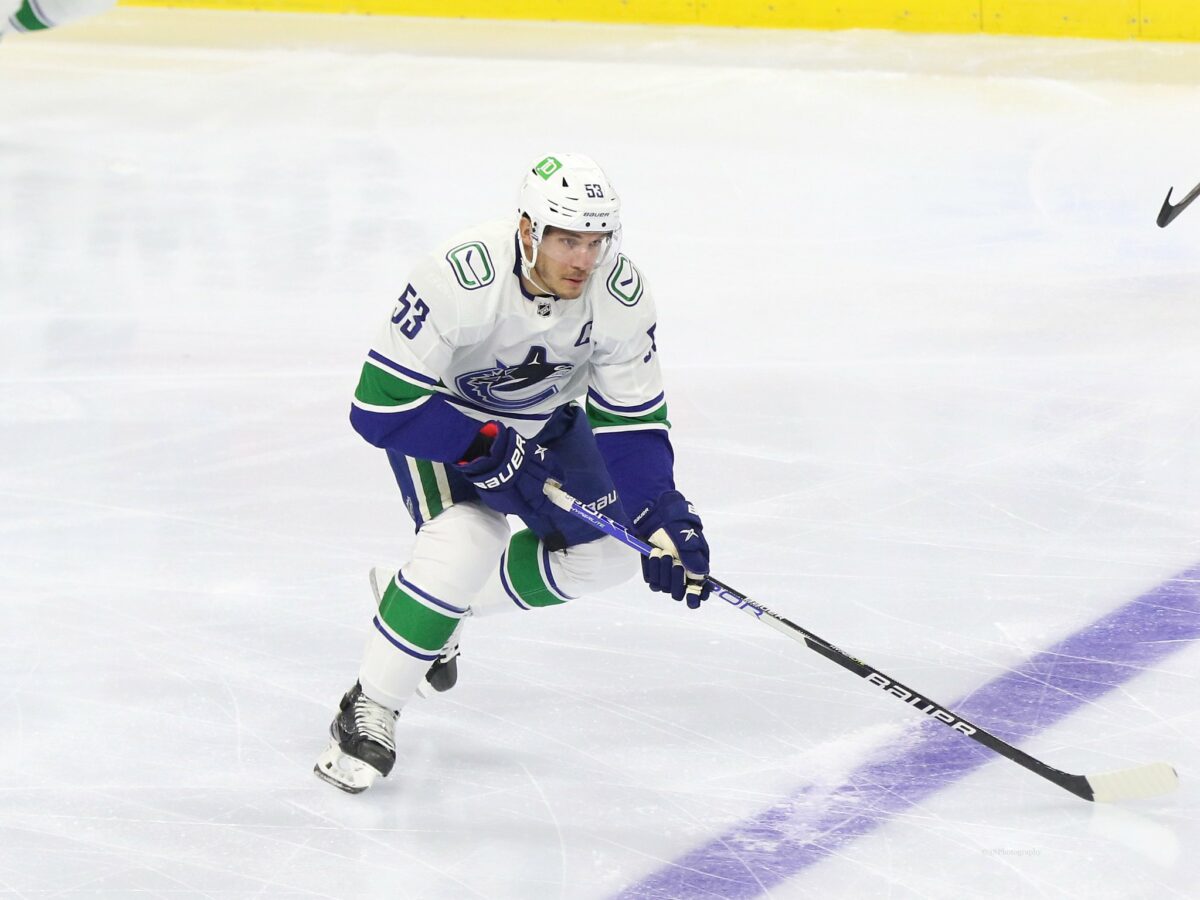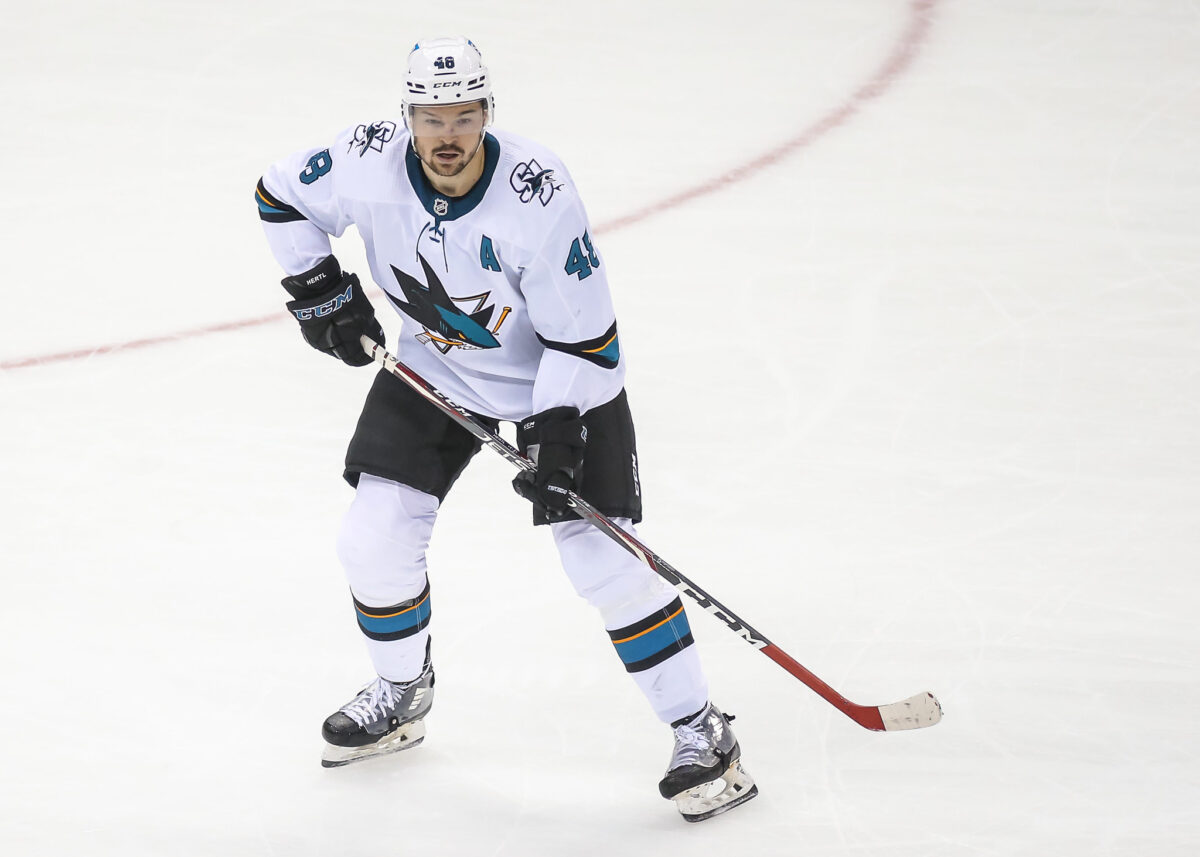This offseason should be a relatively busy one for the Vancouver Canucks. They’ll have decisions to make regarding their restricted free agents (RFA), most notably Brock Boeser, and will also look to add in free agency to build off of a strong second half of their 2021-22 campaign. General manager Patrick Allvin, president of hockey operations Jim Rutherford, and assistant general managers Émilie Castonguay and Cammi Granato might also want to start thinking about the free-agent class for next season, which includes their captain Bo Horvat. As conversations inevitably pick up, it gives us a chance to predict Horvat’s next contract extension.
Horvat will be entering the final year of a six-year, $33 million extension signed in 2017, worth an average annual value (AAV) of $5.5 million. Along with J.T. Miller, Horvat will be up for a significant and well-deserved pay raise. He was named captain of the Canucks on Oct. 9 ahead of the 2019-20 season, the 14th in franchise history.
Related: Canucks 2022 Offseason Trade Targets: Toronto Maple Leafs
Evaluating his recent production and player comparisons from around the league, we’ll break down what a contract could look like for the former ninth overall pick in the 2013 NHL Entry Draft.
Horvat’s Recent Production
Despite missing 12 games this season due to injury, Horvat scored the highest goal total of his career, with 31 goals to go along with 21 assists. His previous career-high was 27 goals (2018-19) scored in a full 82 games. While expecting him to continue to hit the 40-goal mark would be optimistic, scoring 30 is a realistic expectation for the 27-year-old moving forward. Horvat has hit the 20-goal plateau five times in his career while putting up 50 points or more four separate times, including a 61-point season in 2018-19.

Horvat’s production is not all about goals and assists. A big difference between this season and the ones before was his shooting percentage (S%), where he scored on a career-high 16% of his shots. He is also one of the best in the business in the face-off circle, winning 57.02% of his faceoffs this season, and among players who took at least 400 draws, he was ranked in the top 10.
Fun fact, Horvat has never finished a season with a faceoff percentage (F%) below 50%; his lowest was during his sophomore season when he won 50.9% of his draws. He has also been solid in the analytical deportment, with a Corsi for percentage (CF%) at even strength of 51.8% this season, his best in that category to date.
You may also like:
- Canucks Draft Misses Since 2015
- Canucks’ Top 15 Prospects for 2024-25 Season
- Daniel Sprong: What to Expect From Canucks’ Newest Signing
- Vancouver Canucks Sign Daniel Sprong to 1-Year Deal
- 5 NHL Teams That Improved in Free Agency
The Athletic‘s Dom Luszczyszyn has a Game Score Value Added (GSVA) program that breaks down a player’s on-ice value and market value, projecting it over the future. While it’s not a perfect model, it offers a bit of perspective on what a player brings and their value based on their salary. Horvat’s GSVA shows he outplayed his contract by nearly $1 million this season, producing roughly at a $6.5 million projection while also having an on-ice value of 1.7 wins.
Now, as a player ages, their game will reflect that to a certain extent, and in this case, “The model sees Horvat as likely to remain a top-six caliber contributor into his 30s but suggests that his overall value is likely to dip below $6 million by 2023-24 and below $5 million a couple of years later. As such, GSVA considers a long-term Horvat extension to be a relatively risky proposition unless the annual average value of the deal is tightly managed” (from ‘How should the Canucks approach extension talks with Miller, Boeser and Horvat?’ The Athletic, June 6, 2022).
Taking all of that information into consideration, the next order of business is to compare Horvat to players around the league.
Horvat’s Player Comparables
Anytime a player’s contract is up for renewal, outside of looking at their individual stats, players around the league with similar stats and value present a good bar for understanding their next deal. There were a few players to consider here, such as Kevin Hayes of the Philadelphia Flyers and Matt Duchene of the Nashville Predators, but they didn’t fit the criteria as well as others.
The following players stand out because they play center, have had similar production, and are around the same age while recently signing a deal to match what Horvat might get.
Tomas Hertl
Another former first-round pick (17th overall in 2012), Tomas Hertl, seems to be the favorite comparable, being just a year older (28) and recently signing an eight-year, $65.1 million extension in March with an AAV of $8.137 million. Like Horvat, Hertl hit the 30-goal mark in 2021-22, scoring 30 goals and 34 assists. The only difference is that Hertl has scored 30 goals in the past, notching 35 in the 2018-19 campaign, which was his most productive season with 74 points in 77 games.

There are plenty of similarities between the two as well. Hertl isn’t nearly as efficient in the faceoff dot as Horvat, but he still won 52.5% of his draws last year and has won 54.1% over his last three seasons. Hertl has a more active stick in the defensive and neutral zones, taking the puck away more than twice as much, with 65 takeaways to Horvat’s 32 in 2022. Where Horvat does have the edge is his CF%, and while Hertl isn’t lacking in this department, he did have a down year, posting a 49.5 CF%, which is a far cry from his career average of 53.3%.
Whether it’s point totals or deeper analytical breakdowns, Hertl seems to be the best comparable and benchmark for a Horvat extension.
Brayden Schenn
While he’s been in the league longer, Brayden Schenn has settled into a similar role as Horvat in terms of production. Schenn also inked an eight-year extension worth $52 million in 2019. Schenn now has one of the more team-friendly contracts, with a $6.5 million AAV.
Also a first-round selection (9th overall in 2009 by the Los Angeles Kings), Schenn had one of his most complete seasons this past year, with 24 goals and 34 assists in 62 games and a plus-21. While his points weren’t a career-high, it was his best points-per-game average (PPG) of any season, averaging .94 PPG. He’s also hit the 50-point mark on six different occasions, including scoring a career-high 70 points in 2017-18.
From the defensive and analytical side, Schenn has dipped a bit in production in St. Louis compared to his days with the Philadelphia Flyers. This season, he posted a CF% of 44.7, which is far off the 53.1% he put up three seasons ago. He’s also never been dominant in the faceoff circle, winning just 49.1% of his draws this season and with a 47.4% in the faceoff dot in his career. He does have an active stick, credited with 42 takeaways last season, and is a physical presence on the ice. Schenn had 119 hits this season and has never had less than 109 in a full season throughout his career.
Prediction for Horvat’s Next Deal
The fact is, we don’t know what Horvat will sign for until he does, and with so many variables in play, our guess is as good as any. But having gone through Horvat’s history with the organization, his production through the years, and comparable stats and contracts around the league, an eight-year extension is where I land.
This will be Horvat’s big-ticket contract, and as we’ve seen with other captains (Gabriel Landeskog of the Colorado Avalanche), term was one of the more important factors. As for dollar amount, Hertl’s contract should be closer to Schenn’s, considering it was signed just three months ago, as opposed to three years ago. So, I’m going with $7.85 million, staying just under the $8 million figure (maybe seems like a discount) but close to Hertl’s $8.137 million AAV as opposed to Schenn’s $6.5 million.
Prediction: Eight years, $62.8 million, $7.85 million AAV
The Canucks will get one more season from Horvat at $5.5 million, which he will most certainly outplay as he did this season and in the past. After that, we will wait and see what decisions the Canucks’ brass will come to. But being drafted by the Canucks, playing his entire career in Vancouver so far, and being given the captaincy at just 24 years old, locking him up for most of his career would be a wise decision.